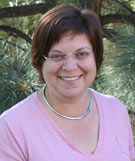Heather Edgar, Associate Professor of Anthropology, helps build the first database of deceased people

Posted: January 15, 2019
People die. All the time. From many causes, including old age, disease, accidents, murder. But researchers can learn from these deaths.
Heather Edgar, forensic anthropologist at The University of New Mexico Office of Medical Investigator (OMI) and associate professor of anthropology, is currently converting a dataset of whole body decedent CT scans into a searchable database that will be available to researchers.
The database will be stored on systems at the UNM Center for Advanced Research Computing, with the help of CARC network and storage specialist Hussein Al-Azzawi. It is being funded by a $702,000 grant from the National Institute of Justice.
“CARC staff helped to develop a safe, secure, long lasting storage solution. Also, they are helping to develop the method by which we will deliver the scans to the researchers,” Edgar said.
Right now, the database is under construction, Edgar said, and the importance of it can’t be over-emphasized. The database will be available by the end of 2019. It will be free to use.
The OMI is only one of two centralized, statewide offices for medico-legal investigation. It is also the only medical examiner’s office in the US that routinely makes CT scans of nearly every individual whose death is investigated. Between 2010 and 2017, the OMI created over 15,000 whole body CT scans, a research resource that is unmatched anywhere. That many high-resolution scans for each body has generated massive amounts of data, requiring a large system that CARC offers to store it.
Medico-legal researchers, anthropologists, and scientists in many other fields will have access to high resolution whole-body scans for uses such as detecting child abuse, survivability of trauma, and more accurate detection of forensic factors such as age and sex. Causes of death are numerous, and include natural deaths, diseases, child abuse, unhelmeted motorcycle crashes, gunshot wounds, and burns. The database will help researchers and criminal investigators to pin down factors such as age, weight, and sex of deceased persons in other cases or research they may be working on.
